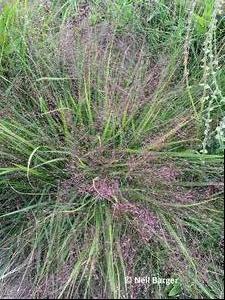Printed at http://www.newmoonnursery.com/index.cfm/
Eragrostis spectabilis
Purple love grass
Native to North America
FIRST IMPRESSIONS: Eragrostis spectabilis is a warm season perennial grass with a phenomenal range of seasonal color and texture. In spring, petite plants form a loose open mound of blue-green blades. In summer, foliage is topped by attractive nebulous clouds of rosy-purple spikelets. As autumn rolls around, foliage develops a bronzy red patina and seed ripens to a soft beige color. This handsome grass flourishes in sunny exposures with poor dry soil.
HABITAT & HARDINESS: Eragrostis spectabilis is an introduced species in Canada. In the United States, plants range from Maine to Florida and west to North Dakota, Wyoming, Colorado and Arizona.
Plants are indigenous to disturbed and undisturbed sandy sites including dry prairies, upland savannas, flatwoods, sandhills, limestone glades, abandoned fields, sandy or gravelly railroad and roadside right-of-ways
This grass is hardy from USDA Zones 5-9.
PLANT DESCRIPTION: Eragrostis spectabilis is a warm season bunch grass with a softly mounding habit. This grass has vigorous fibrous roots and expands slowly from short rhizomes.
Leaf blades are light bluish green, up to 10” long and about 1/4” wide. The blades are smooth and arching with pubescent bases and sheaths. Autumn foliage acquires an attractive reddish hue.
In summer a purple haze of airy panicles rise above the foliage. The individual spikelets are flattened, purplish and about ¼” long. As they mature, seeds assume a buff color and the entire panicle can detach and blow away like a tumbleweed.
Plants are 2’ tall with 2-3’ spread.
CULTURAL & MAINTENANCE NEEDS: Eragrostis spectabilis prospers in full sun and infertile dry sandy or gravelly soil. Plants tolerate drought and can grow in barren areas near black walnut trees.
In disturbed fields, this grass competes with weedy and exotic species and survives detrimental cultivation practices. Plants are also salt tolerant enough to flourish on roadsides that receive winter salt.
This species is a fairly short lived perennial that will reseed to replenish the population. If seeding is undesirable, deadhead after flowering. In garden situations, cut dead foliage to the ground in early spring to make way for new growth.
LANDSCAPE USES: This attractive low growing grass is useful as an Accent, Groundcover, Grouping or Mass Planting. Eragrostis spectabilis provides Showy Flowers, Cut Flowers, Attractive Seedheads, Fall Color and aids in Erosion Control. This species is a candidate for Green Roofs and is appropriate for Water-wise Landscapes, Low Maintenance Plantings, Meadow or Prairie Gardens, Perennial Borders, Rock Gardens and Restoration Projects.
COMPANION & UNDERSTUDY PLANTS: Try pairing Eragrostis spectabilis with Aster divaricatus, Callirhoe involucrata, Carex pensylvanica, Liatris microcephala, Monarda punctata, Rudbeckia fulgida, Schizachrium scoparium, Solidago rigida or Sporobolis heterolepis.
Muhlenbergia capillaris would be a worthy substitute in some situations. It is a taller and broader grass with similar cultural needs and airy pinkish blooms.
TRIVIA: Eragrostis spectabilis is widely used by internationally renowned garden designer Piet Oudolf and was listed as one of his “100 Must-Have Plants” in Gardens Illustrated magazine. The species was extensively planted in Oudolf’s designs for New York City’s Highline and Chicago’s Lurie Garden.
Received the Direct Gardening Association 2013 Green Thumb Award as one of the 5 best new plants of the year.
Hosts caterpillars of the Zabulon skipper. Birds forage on the seed but foliage is not palatable to deer.
Height:
2 ftSpread:
1-2 ftSpacing:
18-24 inUSDA Hardiness Zone:
5-9Bloom Color:
Red, TanEragrostis spectabilis Characteristics
Attracts Wildlife
- Pollinators
- Butterflies
Attributes
- Dried Flower
- Cut Flower
- Coastal
- Naturalizing
- Ground Cover
- Drought Tolerant
Exposure
- Full Sun
Flowering Months
- September
- August
Foliage Color
- Green
Grass Season
- Warm Season Grass
Groundcover Foot-Traffic Tolerances
- Heavy
Growth Rate
- Fast
Lawn Replacement or Groundcover
- Lawn Replacement
Salt Tolerance
- High
Season of Interest (Foliage)
- Fall
- Summer
- Spring
- Winter
Soil Moisture Preference
- Moist to Dry
- Well-Drained
Interesting Notes:
For more information on this plant, visit the USDA PLANTS Database: http://plants.usda.gov/java/profile?symbol=ERSP

